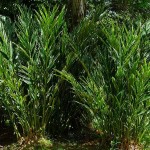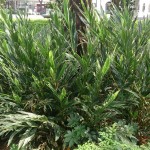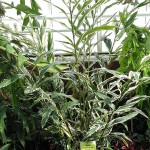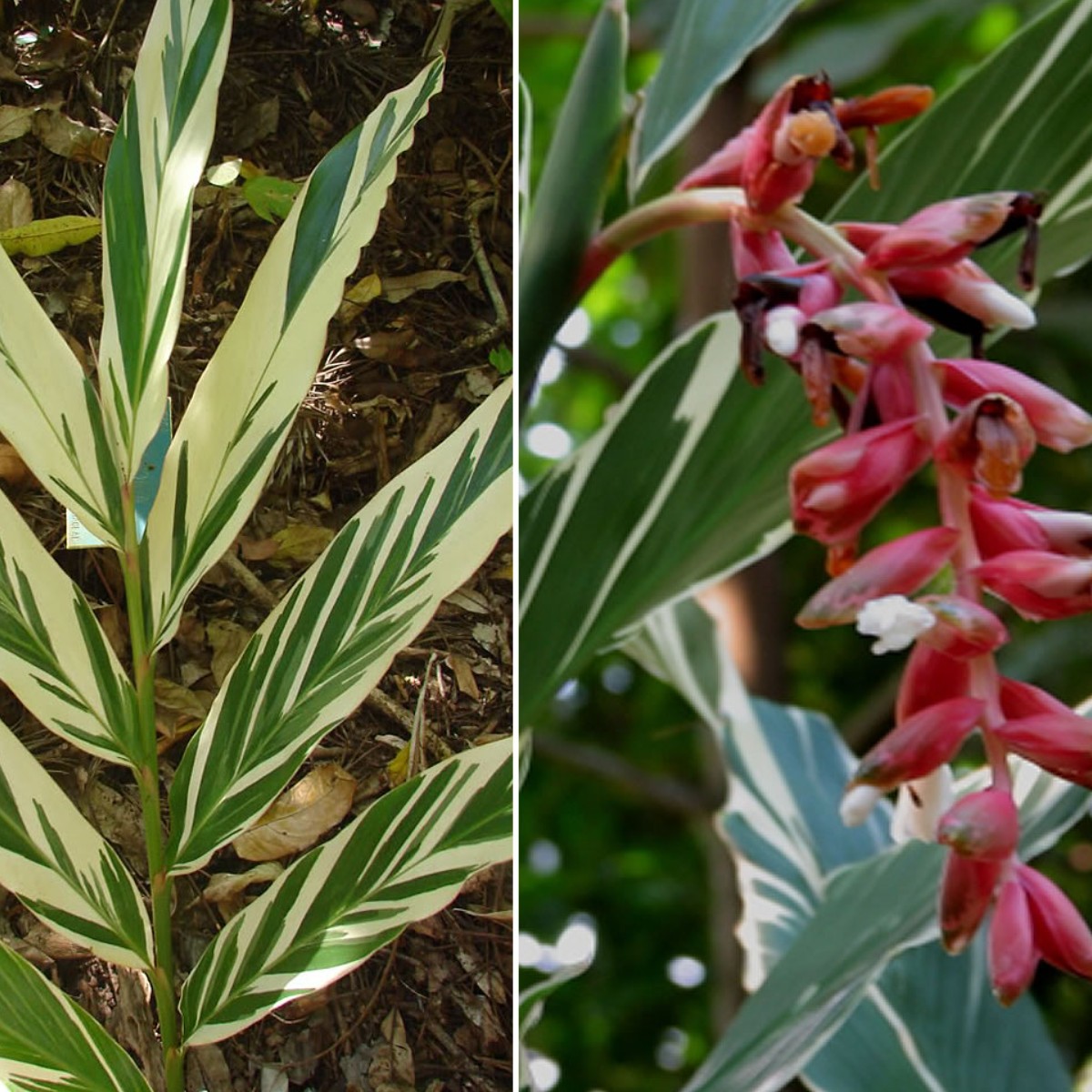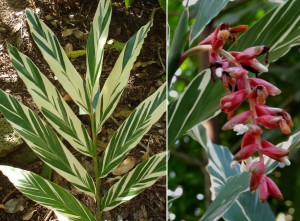Family: Zingiberaceae
Synonymous: Alpinia sanderae
Alpinia tricolor
Guillainia vittata
Distribution and habitat: Alpinia vittata is a species of flowering plants in the ginger family, native to a region from the Bismarck Archipelago in the Solomon Islands. They are evergreen rhizomatous soft-wooded perennial cultivated as ornamental plants. Alpinia vittata are plants of forest understory habitat in hot and moist climate all year round.
This plant is among the most attractive and commonly grown species of this genus.
Description: Alpinia vittata is a tropical, clumping perennial plant that grows from a rhizome. The stems are pseudo-stems - they are made up of many layers, which are leaf sheaths, tightly compressed together. It is growing up to 50cm (20 inch) tall indoor and has green pale, 20cm (8 inch) long leaves edged and banded from the centre to the margin with cream or white stripes. The leaves are more or less lance-shaped, arranged in two ranks on the reed-like pseudo-stems. These plant rarely flower in cultivation.
In the ground in warm climates it can grow to 1.5m (5 feet) tall or more, but tends to stay smaller if grown in pots. It forms a dense clump that makes a good accent plant. Large clumps produce pendulous pink flowers. Inflorescence are 18-25cm (7-10 inch) long. They form only on two years old stems consisting in a pendant branched spike carried terminally on a leafy stem.
Alpinia vittata is cultivated mainly for its beautiful and striking foliage.
Houseplant care: Alpinia vittata is a fast grower and can be used as indoor plant as long as a humid atmosphere is maintained. Remove spent leaves as they form and cut old canes to their base.
Light: Alpinia vittata thrives in medium light or filtered direct sunlight is best. Kept in too dark position will reduce variegation and make the leaves greener. Prolonged direct sunlight can cause foliage to scald, brown or bleach.
During the warm season these plants can be moved outdoor in a spot with partial shade. Bring the plants back indoors before the temperature drops under 15C (59F).
Temperature: During the active growth period, the warmer the better - temperatures must never drop bellow 15C (59F). High humidity is essential; stand Alpinia vittata plants on saucers of moist pebbles throughout the year.
Watering: Correct watering is essentially important for the successful growth of Alpinia vittata plants. As soon as the rhizomes start into growth in early spring begin to water plentifully, as much as necessary to keep the potting mixture thoroughly moist. After the active growth period gradually reduce the quantity and water only moderately during the rest period.
Feeding: Apply to Alpinia vittata a standard liquid fertiliser every two weeks from spring to summer.
Potting and repotting: In mid-spring, transfer Alpinia vittata plants into a pot one size larger. Use a soil-based potting mixture with blood and bone at the rate of one teaspoonful per 15cm (6 inch) pot.
Gardening: Alpinia vittata is best in tropical to sub tropical climates, but can be grown in frost free temperate areas in a warm spot. It can also be grown in a container. In cooler climates, it must be kept indoors or in a greenhouse over winter. This species has light frost tolerance. The tight clumps of tall slender erect stems will die back with freezing temperatures, but the rhizomes will sprout new foliage in spring. If grown in cold regions, the rhizomes can be dug up and stored indoors for the winter. Store them at 13C (55F) in dry pine bark mulch and then restart them in spring after frost danger has passed.
Because Alpinia vittata does not flower until its second year, it can only be enjoyed for its foliage in the cooler areas. These beautiful plants have a massive spread, so give them plenty of room to spread their wings. Place them 1.2 to 1.5m (4-5 feet) apart and allow at least 1.2m (4 feet) between these plants and the nearest shrub or tree. Alpinia vittata grow vigorously and where they spread to outgrow their allotted space in the landscape, rhizomes should be dug up split and replanted. Also, the larger specimens should be sheltered from winds to prevent the leaves from tearing.
The tallest stalks can be trimmed off to keep this plant to a lower size.
Position: Alpinia vittata is not picky when it comes to its location in the garden - it can grow in areas that provide at least six hours of sun and bright light throughout the day but can also thrive in partial shady areas of the garden. But too much shade will reduce variegation and make the leaves greener. Prolonged direct sunlight can cause foliage to scald, brown or bleach.
Soil: Alpinia vittata thrive in loose, but moist rich soil. A sandy soil that has a lot of organic matter is ideal. Before starting the plant, incorporate a layer of compost into it to promote soil moisture retention and provide nutrients. The soil should be mildly acidic (6.0-6.5 pH) to mildly alkaline (7.0-7.5 pH).
In cooler areas, a thick layer of organic mulch might help protect the roots.
The rhizomes should be planted as soon as possible. It is recommended to establish the plant in a pot before planting it in garden. The rhizome should be planted with the top up, no more than 3-4cm under the soil. Avoid planting them too deep to prevent rhizomes from rotting. Also, freshly planted rhizomes need oxygen to grow new roots and will die if the planting medium is too dense or too wet.
If planted in pots, these should be of sufficient size - at least 10 to 15cm (4-6 inch) wider than rhizome size. Keep the pots in a warm, sunny place. When leaves start to unfold the plants can be planted out - again in well drained soil.
Irrigation: Although Alpinia vittata plants do not mind dry conditions, they will look their best with regular irrigation timed so that the soil has a chance to dry out between waterings. These plants are moderately drought tolerant once established. Water regularly, especially during the initial growing season when the roots are establishing. Avoid overwatering, especially during periods of cool winter weather below 10C (50F), as rhizomes are prone to rot.
Fertiliser: Alpinia vittata will thrive with regular applications (3 times a year: spring, summer and fall) of a high potash (K) fertiliser such as a slow release 8/2/12 palm special. They require far less fertiliser however than palms and will fail to flower if too much is used. Fertilised plants require more water than unfertilised ones.
Propagation: Propagate Alpinia vittata by dividing overgrown clumps in late spring. These can be broken off or cut with secateurs. Pots of divided rhizomes should be kept in a warm, shaded spot for several weeks before being placed in their permanent position.
Alpinia vittata can be started from sections of rhizome in spring using a loose, airy but moist organic potting mixture. Make sure that they are not planted too deep - at most 2.5-5cm (1-2 inch). Avoid overwatering to prevent rhizomes from rotting. After planting, water thoroughly, then do not water again until soil is getting dry. Keep in warm position, evenly moist, but not wet, until shoots grow and leaves start to unfold.
Problems: Generally, Alpinia vittata is problem free.
Red spider mite may infest these plants when are kept in dry atmosphere.
Treatment: Spray with a suitable insecticide and raise the humidity by standing the pot on a saucer of moist pebbles.
The edges of the leaves turn brown if the plant lacks moisture.
Treatment: Water the plants. Spread a thick layer of organic mulch over the soil around the plant to help promote soil moisture retention.
Older leaves will appear pale with brown necrotic areas is caused by insufficient potash. Interveinal yellowing is caused by iron deficiency and distorted leaves by manganese deficiency.
Treatment: Fertilise plants as recommended to correct trace elements, especially they are grown on limestone soils.
Companion plants: Alpinia vittata makes a sticking contrast when planted in landscape along with: Cordyline species, Schefflera arboricola (Green Arboricola), Nephrolepis biserrata cv.'Macho Fern' (Macho Fern), Brugmansia species (Angel's Trumpet), Strelitzia nicolai (White Bird of Paradise), Tibouchina heteromalla (Silverleafed Princess Flower) and Agapanthus species.
Note: Alpinia vittata is often confused with Alpinia zerumbet cv. Variegata. They have different flowers (Alpinia zerumbet cv. Variegata has shell-like flowers, beautiful flowers used in exotic bouquets) and different hardiness zone (again Alpinia zerumbet cv. Variegata is a harder cultivar). The size is again different. These two species also share sometime their common name as 'Variegate Ginger'. Grow Alpinia vittata for its beautiful foliage.
Uses and display:Alpinia vittata is used in tropical landscapes for filling borders, in containers or as building foundation plantings. In cold climates, it often serves as a seasonal container plant for the patio. The foliage can be cut and used in fresh flower arrangements. It makes an excellent landscape plant that is easily cared for. Great for mass plantings and border areas. It works as a surround for trees or palms, a filler for a corner bed or an anchor plant for a mixed garden. It is suited for tropical, oriental and contemporary designs gardens. This species in drought-tolerant, therefore it is suitable for xeriscaping.
Alpinia vittata can be used in landscape in many ways such as: single yard specimen, center of a circular drive, large accent for a mixed bed, backdrop for smaller plants, in front of tall green shrubs, corner-of-the-house accent, pool cage plant (for a large bed), surrounding a palm tree or as an understory plant among large trees.
SUMMARY:
CHARACTERISTICS:
Foliage variegated
Shape bushy
Height - 1.8m (6 feet)
Wide - 0.8m (3 feet)
PROPER CARE:
Watering in rest period sparingly
Watering in active growth period moderately
Light bight filtered
Temperature in rest period min 13C max 21C (55-70F)
Temperature in active growth period min 16C max 27C (61-81F)
Humidity high
Hardiness zone: 9a-11
